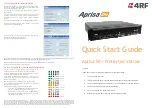
UAV-1000xxx-001
ECCN 7A994
Page
27 | 32
10 Post Installation Checks
Post installation checks should be carried out in accordance with your
certification requirements.
•
Mode S interrogations to verify correct address programming.
•
Verification of the reported altitude using a static tester.
•
Interrogations to verify the receiver sensitivity. A mode S transponder
should have a minimum triggering level (MTL) of between -77dBm
and -71dBm. Failure to meet this requirement usually indicates an
antenna or coaxial cable problem.
•
Interrogations to verify the transmitted power. A Class 1 installation
should have no less than 16watts at the antenna (and no more than
25watts). Failure to meet this requirement is also generally due to
antenna or wiring issues.
•
Verification of the GPS position source and ADS-B outputs.
Whenever a valid position is received by the transponder and the
transponder is in any mode other than standby, ADS-B Extended
Squitter messages should be observed on the transponder test set.
11 Continued Airworthiness
Other than for periodic functional checks required by the regulations,
Ping20S
has been designed and manufactured to allow “on condition
maintenance”. This means that there are no periodic service requirements
necessary to maintain continued airworthiness, and no maintenance is
required until the equipment does not properly perform its intended
function. When service is required, a complete performance test should be
accomplished following any repair action. Repairs should only be carried
out in accordance with uAvionix service procedures.















































